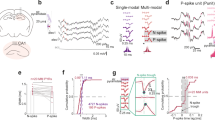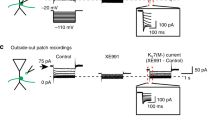Abstract
Action potential generation and conduction requires large quantities of energy to restore Na+ and K+ ion gradients. We investigated the subcellular location and voltage dependence of this metabolic cost in rat neocortical pyramidal neurons. Using Na+/K+ charge overlap as a measure of action potential energy efficiency, we found that action potential initiation in the axon initial segment (AIS) and forward propagation into the axon were energetically inefficient, depending on the resting membrane potential. In contrast, action potential backpropagation into dendrites was efficient. Computer simulations predicted that, although the AIS and nodes of Ranvier had the highest metabolic cost per membrane area, action potential backpropagation into the dendrites and forward propagation into axon collaterals dominated energy consumption in cortical pyramidal neurons. Finally, we found that the high metabolic cost of action potential initiation and propagation down the axon is a trade-off between energy minimization and maximization of the conduction reliability of high-frequency action potentials.
This is a preview of subscription content, access via your institution
Access options
Subscribe to this journal
Receive 12 print issues and online access
$209.00 per year
only $17.42 per issue
Buy this article
- Purchase on Springer Link
- Instant access to full article PDF
Prices may be subject to local taxes which are calculated during checkout







Similar content being viewed by others
References
Attwell, D. & Laughlin, S.B. An energy budget for signaling in the grey matter of the brain. J. Cereb. Blood Flow Metab. 21, 1133–1145 (2001).
Aiello, L. & Wheeler, P. The expensive-tissue hypothesis: the brain and the digestive system in human and primate evolution. Curr. Anthropol. 36, 199–221 (1995).
Crotty, P., Sangrey, T. & Levy, W.B. Metabolic energy cost of action potential velocity. J. Neurophysiol. 96, 1237–1246 (2006).
Herculano-Houzel, S. Scaling of brain metabolism with a fixed energy budget per neuron: implications for neuronal activity, plasticity and evolution. PLoS ONE 6, e17514 (2011).
Hodgkin, A. The optimum density of sodium channels in an unmyelinated nerve. Phil. Trans. R. Soc. Lond. B 270, 297–300 (1975).
Lennie, P. The cost of cortical computation. Curr. Biol. 13, 493–497 (2003).
Levy, W.B. & Baxter, R.A. Energy efficient neural codes. Neural Comput. 8, 531–543 (1996).
de Haas, V. & Vogel, W. Sodium and potassium currents recorded during an action potential. Eur. Biophys. J. 17, 49–51 (1989).
Frankenhaeuser, B. & Huxley, A.F. The action potential in the myelinated nerve fiber of Xenopus laevis as computed on the basis of voltage clamp data. J. Physiol. (Lond.) 171, 302–315 (1964).
Alle, H., Roth, A. & Geiger, J.R.P. Energy-efficient action potentials in hippocampal mossy fibers. Science 325, 1405–1408 (2009).
Carter, B.C. & Bean, B.P. Sodium entry during action potentials of mammalian neurons: incomplete inactivation and reduced metabolic efficiency in fast-spiking neurons. Neuron 64, 898–909 (2009).
Sengupta, B., Stemmler, M., Laughlin, S.B. & Niven, J.E. Action potential energy efficiency varies among neuron types in vertebrates and invertebrates. PLOS Comput. Biol. 6, e1000840 (2010).
Kole, M.H.P., Letzkus, J. & Stuart, G. Axon initial segment Kv1 channels control axonal action potential waveform and synaptic efficacy. Neuron 55, 633–647 (2007).
Shu, Y., Yu, Y., Yang, J. & McCormick, D.A. Selective control of cortical axonal spikes by a slowly inactivating K+ current. Proc. Natl. Acad. Sci. USA 104, 11453–11458 (2007).
Geiger, J.R.P. & Jonas, P. Dynamic control of presynaptic Ca2+ inflow by fast-inactivating K+ channels in hippocampal mossy fiber boutons. Neuron 28, 927–939 (2000).
Kole, M.H. & Stuart, G.J. Signal processing in the axon initial segment. Neuron 73, 235–247 (2012).
Carter, B.C. & Bean, B.P. Incomplete inactivation and rapid recovery of voltage-dependent sodium channels during high-frequency firing in cerebellar Purkinje neurons. J. Neurophysiol. 105, 860–871 (2011).
Hodgkin, A.L. & Huxley, A.F. A quantitative description of membrane current and its application to conduction and excitation in nerve. J. Physiol. (Lond.) 117, 500–544 (1952).
Cole, K.S. & Curtis, H.J. Electric impedance of the squid giant axon during activity. J. Gen. Physiol. 22, 649–670 (1939).
Hasenstaub, A., Otte, S., Callaway, E. & Sejnowski, T.J. Metabolic cost as a unifying principle governing neuronal biophysics. Proc. Natl. Acad. Sci. USA 107, 12329–12334 (2010).
Lorincz, A. & Nusser, Z. Molecular identity of dendritic voltage-gated sodium channels. Science 328, 906–909 (2010).
Alle, H., Kubota, H. & Geiger, J.R. Sparse, but highly efficient, Kv3 outpace BKCa channels in action potential repolarization at hippocampal mossy fiber boutons. J. Neurosci. 31, 8001–8012 (2011).
Zagotta, W.N., Hoshi, T. & Aldrich, R.W. Shaker potassium channel gating. III. Evaluation of kinetic models for activation. J. Gen. Physiol. 103, 321–362 (1994).
Schmidt-Hieber, C. & Bischofberger, J. Fast sodium channel gating supports localized and efficient axonal action potential initiation. J. Neurosci. 30, 10233–10242 (2010).
Shu, Y., Hasenstaub, A., Duque, A., Yu, Y. & McCormick, D.A. Modulation of intracortical synaptic potentials by presynaptic somatic membrane potential. Nature 441, 761–765 (2006).
Harris, J.J. & Attwell, D. The energetics of CNS white matter. J. Neurosci. 32, 356–371 (2012).
Oberlaender, M. et al. Three-dimensional axon morphologies of individual layer 5 neurons indicate cell type–specific intracortical pathways for whisker motion and touch. Proc. Natl. Acad. Sci. USA 108, 4188–4193 (2011).
Oberlaender, M. et al. Cell type–specific three-dimensional structure of thalamocortical circuits in a column of rat vibrissal cortex. Cereb. Cortex (2011).
de Kock, C.P. & Sakmann, B. High frequency action potential bursts (>100 Hz) in L2/3 and L5B thick tufted neurons in anaesthetized and awake rat primary somatosensory cortex. J. Physiol. (Lond.) 586, 3353–3364 (2008).
Raman, I.M. & Bean, B.P. Resurgent sodium current and action potential formation in dissociated cerebellar Purkinje neurons. J. Neurosci. 17, 4517–4526 (1997).
Gittis, A.H., Moghadam, S.H. & du Lac, S. Mechanisms of sustained high firing rates in two classes of vestibular nucleus neurons: differential contributions of resurgent Na, Kv3, and BK currents. J. Neurophysiol. 104, 1625–1634 (2010).
Kole, M.H.P. First node of ranvier facilitates high-frequency burst encoding. Neuron 71, 671–682 (2011).
Popovic, M.A., Foust, A.J., Mccormick, D.A. & Zecevic, D. The spatio-temporal characteristics of action potential initiation in layer 5 pyramidal neurons: a voltage-imaging study. J. Physiol. (Lond.) 589, 4167–4187 (2011).
Engel, D. & Jonas, P. Presynaptic action potential amplification by voltage-gated Na+ channels in hippocampal mossy fiber boutons. Neuron 45, 405–417 (2005).
Schoppa, N.E. & Sigworth, F.J. Activation of Shaker potassium channels. III. An activation gating model for wild-type and V2 mutant channels. J. Gen. Physiol. 111, 313–342 (1998).
Yellen, G. The voltage-gated potassium channels and their relatives. Nature 419, 35–42 (2002).
Stühmer, W. et al. Molecular basis of functional diversity of voltage-gated potassium channels in mammalian brain. EMBO J. 8, 3235–3244 (1989).
Hopkins, W.F. Toxin and subunit specificity of blocking affinity of three peptide toxins for heteromultimeric, voltage-gated potassium channels expressed in Xenopus oocytes. J. Pharmacol. Exp. Ther. 285, 1051–1060 (1998).
Ogawa, Y. et al. Postsynaptic density 93 clusters Kv1 channels at axon initial segments independently of Caspr2. J. Neurosci. 28, 5731–5739 (2008).
Rhodes, K.J. et al. Association and colocalization of the Kvbeta1 and Kvbeta2 beta-subunits with Kv1 alpha-subunits in mammalian brain K+ channel complexes. J. Neurosci. 17, 8246–8258 (1997).
Wang, H., Kunkel, D.D., Schwartzkroin, P.A. & Tempel, B.L. Localization of Kv1.1 and Kv1.2, two K channel proteins, to synaptic terminals, somata, and dendrites in the mouse brain. J. Neurosci. 14, 4588–4599 (1994).
Lorincz, A. & Nusser, Z. Cell type–dependent molecular composition of the axon initial segment. J. Neurosci. 28, 14329–14340 (2008).
Niven, J.E. Energy limitation as a selective pressure on the evolution of sensory systems. J. Exp. Biol. 211, 1792–1804 (2008).
Juusola, M., Robinson, H.P.C. & De Polavieja, G.G. Coding with spike shapes and graded potentials in cortical networks. Bioessays 29, 178–187 (2007).
Wang, S.S.-H. et al. Functional trade-offs in white matter axonal scaling. J. Neurosci. 28, 4047–4056 (2008).
Kole, M.H.P. et al. Action potential generation requires a high sodium channel density in the axon initial segment. Nat. Neurosci. 11, 178–186 (2008).
Hallermann, S. et al. Bassoon speeds vesicle reloading at a central excitatory synapse. Neuron 68, 710–723 (2010).
Carnevale, N.T. & Hines, M.L. The NEURON book (Cambridge University Press, Cambridge, 2005).
Kole, M.H.P. & Stuart, G.J. Is action potential threshold lowest in the axon? Nat. Neurosci. 11, 1253–1255 (2008).
Mainen, Z.F. & Sejnowski, T.J. Influence of dendritic structure on firing pattern in model neocortical neurons. Nature 382, 363–366 (1996).
Awatramani, G.B., Price, G.D. & Trussell, L.O. Modulation of transmitter release by presynaptic resting potential and background calcium levels. Neuron 48, 109–121 (2005).
Christie, J.M., Chiu, D.N. & Jahr, C.E. Ca2+-dependent enhancement of release by subthreshold somatic depolarization. Nat. Neurosci. 14, 62–68 (2011).
Kole, M.H.P., Hallermann, S. & Stuart, G.J. Single Ih channels in pyramidal neuron dendrites: properties, distribution, and impact on action potential output. J. Neurosci. 26, 1677–1687 (2006).
Lohmann, H. & Rörig, B. Long-range horizontal connections between supragranular pyramidal cells in the extrastriate visual cortex of the rat. J. Comp. Neurol. 344, 543–558 (1994).
Guan, D., Tkatch, T., Surmeier, D.J., Armstrong, W.E. & Foehring, R.C. Kv2 subunits underlie slowly inactivating potassium current in rat neocortical pyramidal neurons. J. Physiol. (Lond.) 581, 941–960 (2007).
Bekkers, J.M. & Delaney, A.J. Modulation of excitability by α-dendrotoxin–sensitive potassium channels in neocortical pyramidal neurons. J. Neurosci. 21, 6553–6560 (2001).
Keren, N., Bar-Yehuda, D. & Korngreen, A. Experimentally guided modeling of dendritic excitability in rat neocortical pyramidal neurones. J. Physiol. (Lond.) 587, 1413–1437 (2009).
Braitenberg, V. & Schüz, A. Cortex: Statistics and Geometry of Neuronal Connectivity (Springer, London, 1998).
Markram, H., Lübke, J., Frotscher, M., Roth, A. & Sakmann, B. Physiology and anatomy of synaptic connections between thick tufted pyramidal neurones in the developing rat neocortex. J. Physiol. (Lond.) 500, 409–440 (1997).
Acknowledgements
The research leading to these results has received funding from the European Research Council under the European Community's Seventh Framework Program (FP7/2007–2013)/ERC Grant agreement n° P261114 and from the Australian National Health and Medical Research Council (NHMRC) Project Grant n° 525437 to M.H.P.K. S.H. received funding from the Heisenberg Program of the German Research Foundation (HA 6386/1-1 and 2-1). The authors are grateful to Henrik Alle and Christoph Schmidt-Hieber for discussions on earlier versions of this manuscript.
Author information
Authors and Affiliations
Contributions
S.H. and M.H.P.K. designed and conducted the experiments and analyzed data. C.P.J.d.K. provided the in vivo reconstructions. S.H., C.P.J.d.K., G.J.S. and M.H.P.K. wrote the paper.
Corresponding author
Ethics declarations
Competing interests
The authors declare no competing financial interests.
Supplementary information
Supplementary Text and Figures
Supplementary Figures 1–5 and Supplementary Table 1 (PDF 1164 kb)
Rights and permissions
About this article
Cite this article
Hallermann, S., de Kock, C., Stuart, G. et al. State and location dependence of action potential metabolic cost in cortical pyramidal neurons. Nat Neurosci 15, 1007–1014 (2012). https://doi.org/10.1038/nn.3132
Received:
Accepted:
Published:
Issue Date:
DOI: https://doi.org/10.1038/nn.3132
This article is cited by
-
Memory retention in pyramidal neurons: a unified model of energy-based homo and heterosynaptic plasticity with homeostasis
Cognitive Neurodynamics (2021)
-
Relationship between oxygen consumption and neuronal activity in a defined neural circuit
BMC Biology (2020)
-
Average firing rate rather than temporal pattern determines metabolic cost of activity in thalamocortical relay neurons
Scientific Reports (2019)
-
Cable energy function of cortical axons
Scientific Reports (2016)
-
Myelinating satellite oligodendrocytes are integrated in a glial syncytium constraining neuronal high-frequency activity
Nature Communications (2016)



